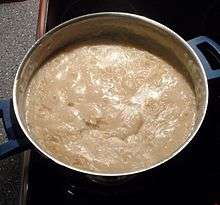Rumford's Soup
 A pot of Rumford’s Soup according to the most basic recipe: pearl barley and dried peas, water, salt and some vinegar. This version has no potatoes. | |
| Type | Soup |
|---|---|
| Region or state | Munich and Bavaria |
| Creator | Benjamin Thompson |
| Main ingredients | Pearl barley, dried yellow peas, potatoes, beer |
|
| |
Rumford's Soup (Rumfordsche Suppe, also called economy soup)[1][2] was an early effort in scientific nutrition. It was invented by Count Rumford circa 1800 and consumed in Munich and greater Bavaria,[2] where he was employed as an advisor to the Duke. It was used as a ration for the poor,[3][4] for Bavarian workhouses[5] and military workhouses,[6] and prisoners. Count Rumford has been credited in many instances for "establishing the first real soup kitchen".[7]
As a reformatory measure, the Bavarian government intended to institute workhouses for those on welfare. Rumford's charge was to provide the cheapest possible ration that was still a high-calorie, nutritious food. The soup became to be well-known among philanthropic-minded people throughout Germany at the time, and Rumford set up his soup kitchens in many German cities.[8]
Rumford's soup became to be commonly used for military rations.[5] It was a common base for inexpensive military rations in Central Europe for much of the nineteenth and twentieth century.
Ingredients
Rumford's soup contained equal parts of pearl barley or barley meal and dried peas,[3][9][10] vegetables,[10] four parts potato, salt according to need, and sour beer,[5][10] slowly boiled until thick. The use of potatoes came into use in later versions of the soup.[6] It was typically eaten with bread. It has been stated that Rumford's recipe called for the bread to be served uncooked, and "added just before serving the soup".[9][11] One account describes the soup as being poured atop the bread just prior to serving.[6] Rumford noted that the barley served to significantly thicken the soup and provide a richness to it, and he considered the cereal grain as "the rice of Great Britain".[6] Some versions were composed of cereals, minor amounts of meat and other ingredients.[1] Not noted as particularly tasty, it is palatable with long, slow cooking.
Nutrition
Rumford's Soup was designed to provide a high degree of nutrition at a minimal expense.[1] It has been estimated that the soup provided one-third of a person's minimal (daily) nutrition requirements.[12] Rumford's soup is naturally low-fat, with high protein content from the dried peas, and both complex carbohydrates from the potato and barley and simple carbohydrates from the beer. Given the knowledge of the day, it was close to an optimum solution to the problem of creating cheap, nutritious food. Unfortunately, the need for vitamins and trace elements was unknown, and Rumford's soup was sometimes supplemented with corn or herring[5] to supply adequate Vitamin C and Vitamin D.
In popular culture
The soup is still served in contemporary times, such as at Oktoberfest celebrations in Munich.[13]
See also
References
- 1 2 3 Hagemann, G. (2007). Reciprocity and Redistribution: Work and Welfare Reconsidered. 4. Plus-Pisa University Press. p. 222. ISBN 978-88-8492-465-0. Retrieved January 24, 2015.
- 1 2 Walker, H. (1996). Cooks and Other People. Oxford symposium on food and cookery. Prospect Books. p. 175. ISBN 978-0-907325-72-7. Retrieved January 24, 2015.
- 1 2 Kellogg, D.O.; Baynes, T.S.; Smith, W.R. (1903). The Encyclopædia Britannica: New American supplement. A-ZUY. The Encyclopædia Britannica: A Dictionary of Arts, Sciences, and General Literature. Original 9th Ed. in 25 Vols. Werner. p. 673. Retrieved January 24, 2015.
- ↑ Report from His Majesty's Commissioners for inquiring into the Administration and practical Operation of the Poor Laws: Appendix. F. Foreign Communications. - 1834. - CIV, 722 S., S. 743 - 756. 1834. p. 382. Retrieved January 24, 2015.
- 1 2 3 4 Luxemburg, R.; Hudis, P. (2013). The Complete Works of Rosa Luxemburg, Volume I: Volume I: Economic Writings I. Verso Books. p. 781. ISBN 978-1-84467-975-1. Retrieved January 24, 2015.
- 1 2 3 4 Dallas, E.S. (1865). Once a Week. Bradbury & Evans. p. 664. Retrieved January 24, 2015.
- ↑ Bramen, Lisa (December 29, 2010). "Count Rumford and the History of the Soup Kitchen". Smithsonian. Retrieved January 24, 2015.
- ↑ Wilde, O. (1990). The Woman's World. Source Book Press. p. 280. Retrieved January 24, 2015. ISSN 0043-7425
- 1 2 Popular Science. Bonnier Corporation. p. 84. Retrieved January 24, 2015. ISSN 0161-7370
- 1 2 3 Klingaman, W.K.; Klingaman, N.P. (2013). The Year Without Summer: 1816 and the Volcano That Darkened the World and Changed History. St. Martin's Press. p. 113. ISBN 978-0-312-67645-2. Retrieved January 24, 2015.
- ↑ Popular Science. Bonnier Corporation. p. 95. Retrieved January 24, 2015. ISSN 0161-7370
- ↑ Wells, R.A.E. (1977). Dearth and Distress in Yorkshire, 1793-1802. Borthwick papers. University of York, Borthwick Institute of Historical Research. p. 21. ISBN 978-0-900701-45-0. Retrieved January 24, 2015.
- ↑ Wolff, M. (2013). Meet Me in Munich: A Beer Lover's Guide to Oktoberfest. Skyhorse Publishing Company, Incorporated. p. 232. ISBN 978-1-62873-510-9. Retrieved January 24, 2015.
Further reading
- Lucas, S. (1862). Once a Week: An Illustrated Miscellany of Literature, Art, Science & Popular Information. Bradbury, Evans & Company. Retrieved January 24, 2015.
- Walker, H. (1991). Oxford Symposium on Food & Cookery, 1990: Feasting and Fasting : Proceedings. Oxford Symposium on food & cookery. Prospect Books. p. 130. ISBN 978-0-907325-46-8. Retrieved January 24, 2015.
- Gunderson, G.W. (2003). The National School Lunch Program: Background and Development. Nova Science Publishers. pp. 1–2. ISBN 978-1-59033-639-7. Retrieved January 24, 2015.
- Molnár T. B. & Bittera Dóra: A gróf sparheltja (The count's cooking range). Magyar Nemzet, 23 April 2005.
- "On the benefits of thermodynamics". MTA Wigner Fizikai Kutatóközpont Részecske- és Magfizikai Intézet. Retrieved January 24, 2015.